Salt and Aroma Compound Distributions Influence Flavour Release and Temporal Perception While Eating Hot-Served Flans
Abstract
1. Introduction
2. Results
2.1. General Considerations
2.2. Descriptive Analysis
2.3. In Vivo Aroma Compound Release
2.4. Time–Intensity Sensory Study
2.5. Temporal Dominance of Sensations
3. Discussion
4. Materials and Methods
4.1. Four-Layer Cream-Based Snack Formulation
4.2. Determination of Salt and Volatile Compound Concentrations
4.3. Simultaneous Measurements of In Vivo Aroma Compound Release Kinetics and Temporal Perception
4.3.1. In Vivo Aroma Compound Release Monitoring
4.3.2. Alternate Time–Intensity
4.4. Sensory Analysis Methods
4.4.1. General Common Conditions
4.4.2. Descriptive Analysis (DA)
4.4.3. Temporal Dominance of Sensation (TDS)
4.5. Data Analysis
4.5.1. Time–Intensity
4.5.2. Descriptive Analysis
4.5.3. Temporal Dominance of Sensations
5. Conclusions
Author Contributions
Funding
Institutional Review Board Statement
Informed Consent Statement
Data Availability Statement
Acknowledgments
Conflicts of Interest
Sample Availability
References
- AFSSA. Rapport du groupe de travail sur le sel; Agence Française de Sécurité Sanitaire des Aliments (AFSSA): Paris, France, 2002; p. 86. [Google Scholar]
- LeatherheadFoodResearch. Evaluation of Technological Approaches to Salt Redution; Food and Drink Federation and British Retail Consortium: London, UK, 2012; pp. 26–27. [Google Scholar]
- World Health Organisation. The SHAKE Technical Package for Salt Reduction; World Health Organisation: Geneva, Switzerland, 2016. [Google Scholar]
- World Health Organisation. Reducing Salt Intake in Populations: Report of a WHO Forum and Technical Meeting; World Health Organisation: Geneva Switzerland, 2007. [Google Scholar]
- Hyseni, L.; Elliot-Green, A.; Lloyd-Williams, F.; Kypridemos, C.; O’Flaherty, M.; McGill, R.; Orton, L.; Bromley, H.; Cappuccio, F.P.; Capewell, S. Systematic review of dietary salt reduction policies: Evidence for an effectiveness hierarchy? PLoS ONE 2017, 12, e0177535. [Google Scholar] [CrossRef]
- World Health Organisation. Guideline: Sodium Intake for Adults and Children; World Health Organisation: Geneva, Switzerland, 2012. [Google Scholar]
- Liem, D.G.; Miremadi, F.; Keast, R.S.J. Reducing sodium in foods: The effect on flavor. Nutrients 2011, 3, 694–711. [Google Scholar] [CrossRef]
- Walsh, C. Consumer responses to low-salt foods. In Reducing Salt in Foods: Practical Strategies; Kilcast, D., Angus, F., Eds.; Woodhead Publishing in Food Science, Technology and Nutrition: Cambridge, UK, 2007; pp. 124–133. [Google Scholar]
- Jaenke, R.; Barzi, F.; McMahon, E.; Webster, J.; Brimblecombe, J. Consumer acceptance of reformulated food products: A systematic review and meta-analysis of salt-reduced foods. Crit. Rev. Food Sci. Nut. 2017, 57, 3357–3372. [Google Scholar] [CrossRef]
- Campo, R.; Rosato, P.; Giagnacovo, D. Less salt, same taste: Food marketing strategies via healthier products. Sustainability 2020, 12, 3916. [Google Scholar] [CrossRef]
- Akan, E.; Yerlikaya, O.; Kinik, O. Importance of salt in dairy products and sodium reduction strategies in food and dairy products. Agro. Food Ind. Hi Tech. 2017, 28, 60–62. [Google Scholar]
- Inguglia, E.S.; Zhang, Z.H.; Tiwari, B.K.; Kerry, J.P.; Burgess, C.M. Salt reduction strategies in processed meat products - A review. Trends Food Sci. Technol. 2017, 59, 70–78. [Google Scholar] [CrossRef]
- Kuo, W.-Y.; Lee, Y. Descriptive and Temporal Saltiness Perception Properties of Model Solid Lipoproteic Colloid Foods-Implications for Sodium Reduction. J. Food Sci. 2017, 82, 1702–1712. [Google Scholar] [CrossRef]
- Thomas-Danguin, T.; Guichard, E.; Salles, C. Cross-modal interactions as a strategy to enhance salty taste and to maintain liking of low-salt food: A review. Food Funct. 2019, 10, 5269–5281. [Google Scholar] [CrossRef]
- Busch, J.L.; Tournier, C.; Knoop, J.E.; Kooyman, G.; Smit, G. Temporal contrast of salt delivery in mouth increases salt perception. Chem. Senses 2009, 34, 341–348. [Google Scholar] [CrossRef]
- Mosca, A.C.; van de Velde, F.; Bult, J.H.F.; van Boekel, M.A.J.S.; Stieger, M. Enhancement of sweetness intensity in gels by inhomogeneous distribution of sucrose. Food Qual. Prefer. 2010, 21, 837–842. [Google Scholar] [CrossRef]
- Mosca, A.C.; Bult, J.H.F.; Stieger, M. Effect of spatial distribution of tastants on taste intensity, fluctuation of taste intensity and consumer preference of (semi-)solid food products. Food Qual. Prefer. 2013, 28, 182–187. [Google Scholar] [CrossRef]
- Mosca, A.C.; Rocha, J.A.; Sala, G.; van de Velde, F.; Stieger, M. Inhomogeneous distribution of fat enhances the perception of fat-related sensory attributes in gelled foods. Food Hydrocolloid. 2012, 27, 448–455. [Google Scholar] [CrossRef]
- Nakao, S.; Ishihara, S.; Nakauma, M.; Funami, T. Inhomogeneous spatial distribution of aroma compounds in food gels for enhancement of perceived aroma intensity and muscle activity during oral processing. J. Texture Stud. 2013, 44, 289–300. [Google Scholar] [CrossRef]
- Nakao, S.; Ishihara, S.; Nakauma, M.; Funami, T. Effects of inhomogeneous spatial distribution of aroma compounds on perceived aroma intensity and human eating behavior for neutral pH gels. Food Sci. Technol. Res. 2013, 19, 675–683. [Google Scholar] [CrossRef][Green Version]
- Noort, M.W.J.; Bult, J.H.F.; Stieger, M.; Hamer, R.J. Saltiness enhancement in bread by inhomogeneous spatial distribution of sodium chloride. J. Cereal Sci. 2010, 52, 378–386. [Google Scholar] [CrossRef]
- Emorine, M.; Septier, C.; Thomas-Danguin, T.; Salles, C. Heterogeneous salt distribution in hot snacks enhances saltiness without loss of acceptability. Food Res. Int. 2013, 51, 641–647. [Google Scholar] [CrossRef]
- Xiong, Y.; Deng, B.R.; Warner, R.D.; Fang, Z.X. Reducing salt content in beef frankfurter by edible coating to achieve inhomogeneous salt distribution. Int. J. Food Sci. Technol. 2020, 55, 2911–2919. [Google Scholar] [CrossRef]
- Stevenson, R.J.; Prescott, J.; Boakes, R.A. Confusing tastes and smell: How odours can influence the perception of sweet and sour tastes. Chem. Senses 1999, 24, 627–635. [Google Scholar] [CrossRef]
- Lawrence, G.; Salles, C.; Septier, C.; Busch, J.; Thomas-Danguin, T. Odour-taste interactions: A way to enhance saltiness in low-salt content solutions. Food Qual. Prefer. 2009, 20, 241–248. [Google Scholar] [CrossRef]
- Lawrence, G.; Salles, C.; Palicki, O.; Septier, C.; Busch, J.; Thomas-Danguin, T. Using cross-modal interactions to counterbalance salt reduction in solid foods. Int. Dairy J. 2011, 21, 103–110. [Google Scholar] [CrossRef]
- Syarifuddin, A.; Septier, C.; Salles, C.; Thomas-Danguin, T. Reducing salt and fat while maintaining taste: An approach on a model food system. Food Qual. Prefer. 2016, 48, 59–69. [Google Scholar] [CrossRef]
- Emorine, M.; Septier, C.; Andriot, I.; Martin, C.; Salles, C.; Thomas-Danguin, T. Combined heterogeneous distribution of salt and aroma in food enhances salt perception. Food Funct. 2015, 6, 1449–1459. [Google Scholar] [CrossRef]
- Guilloux, M.; Prost, C.; Courcoux, P.; Le Bail, A.; Lethuaut, L. How inhomogeneous salt distribution can affect the sensory properties of salt-reduced multi-component food: Contribution of a mixture experimental design approach applied to pizza. J. Sens. Stud. 2015, 30, 484–498. [Google Scholar] [CrossRef]
- Kuo, W.-Y.; Lee, Y. Effect of Food Matrix on Saltiness Perception-Implications for Sodium Reduction. Compr. Rev. Food Sci. F. 2014, 13, 906–923. [Google Scholar] [CrossRef]
- Salles, C.; Chagnon, M.C.; Feron, G.; Guichard, E.; Laboure, H.; Morzel, M.; Semon, E.; Tarrega, A.; Yven, C. In-Mouth Mechanisms Leading to Flavor Release and Perception. Crit. Rev. Food Sci. Nut. 2011, 51, 67–90. [Google Scholar] [CrossRef] [PubMed]
- Repoux, M.; Laboure, H.; Courcoux, P.; Andriot, I.; Semon, E.; Yven, C.; Feron, G.; Guichard, E. Combined effect of cheese characteristics and food oral processing on in vivo aroma release. Flav. Fragr. J. 2012, 27, 414–423. [Google Scholar] [CrossRef]
- Tarrega, A.; Yven, C.; Semon, E.; Salles, C. Aroma release and chewing activity during eating different model cheeses. Int. Dairy J. 2008, 16, 849–857. [Google Scholar] [CrossRef]
- Thomas-Danguin, T.; Sinding, C.; Tournier, C.; Saint-Eve, A. Multimodal interactions. In Flavor From Food to Behaviors, Wellbeing and Health; Etiévant, P., Guichard, E., Salles, C., Voilley, A., Eds.; Woodhead Publishing, Elsevier Ltd.: Duxford, UK, 2016; pp. 121–141. [Google Scholar]
- Saint-Eve, A.; Martin, N.; Guillemin, H.; Sémon, E.; Guichard, E.; Souchon, I. Flavored Yogurt Complex Viscosity Influences Real-Time Aroma Release in the Mouth and Sensory Properties. J. Agric. Food Chem. 2006, 54, 7794–7803. [Google Scholar] [CrossRef]
- Pionnier, E.; Engel, E.; Salles, C.; Le Quéré, J.L. Interactions between non-volatile water-soluble molecules and aroma compounds in Camembert cheese. Food Chem. 2002, 76, 13–20. [Google Scholar] [CrossRef]
- Jennings, W.G. Influence of temperature and salt addends on vapor equilibration of headspace. Food Sci. 1965, 30, 445–449. [Google Scholar] [CrossRef]
- Voilley, A.; Simatos, D.; Loncin, M. Gas Phase Concentration of Volatiles in Equilibrium with a Liquid Aqueous Phase. Lwt-Food Sci. Technol. 1977, 10, 45–49. [Google Scholar]
- Lawrence, G.; Buchin, S.; Achilleos, C.; Bérodier, F.; Septier, C.; Courcoux, P.; Salles, C. In vivo sodium release and saltiness perception in solid lipoprotein matrices. 1. Effect of composition and texture. J. Agric. Food Chem. 2012, 60, 5287–5298. [Google Scholar] [CrossRef] [PubMed]
- Boisard, L.; Andriot, I.; Arnould, C.; Achilleos, C.; Salles, C.; Guichard, E. Structure and composition of model cheeses influence sodium NMR mobility, kinetics of sodium release and sodium partition coefficients. Food Chem. 2013, 136, 1070–1077. [Google Scholar] [CrossRef] [PubMed]
- Kuo, W.-Y.; Lee, Y. Correlating structural properties to sodium release of model solid lipoproteic colloids. J. Food Eng. 2017, 203, 16–24. [Google Scholar] [CrossRef]
- Wendin, K.; Langton, M.; Caous, L.; Hall, G. Dynamic analyses of sensory and microstructural properties of cream cheese. Food Chem. 2000, 71, 363–378. [Google Scholar] [CrossRef]
- Pereira, R.; Bennett, R.; Hemar, Y.; Campanella, O. Rheological and microstructural characteristics of model processed cheese analogues. J. Texture Stud. 2001, 32, 349–373. [Google Scholar] [CrossRef]
- Lopez, C.; Briard-Bion, V.; Beaucher, E.; Ollivon, M. Multiscale characterization of the organization of triglycerides and phospholipids in Emmental cheese: From the microscopic to the molecular level. J. Agric. Food Chem. 2008, 56, 2406–2414. [Google Scholar] [CrossRef]
- Friel, E.N.; Taylor, A.J. Effect of salivary components on volatile partitioning from solutions. J. Agric. Food Chem. 2001, 49, 3898–3905. [Google Scholar] [CrossRef]
- Le Révérend, F.M.; Hidrio, C.; Fernandes, A.; Aubry, V. Comparison between temporal dominance of sensations and time intensity results. Food Qual. Prefer. 2008, 19, 174–178. [Google Scholar] [CrossRef]
- Pineau, N.; Schlich, P.; Cordelle, S.; Mathonnière, C.; Issanchou, S.; Imbert, A.; Rogeaux, M.; Etiévant, P.; Köster, E. Temporal Dominance of Sensations: Construction of the TDS curves and comparison with time-intensity. Food Qual. Prefer. 2009, 20, 450–455. [Google Scholar] [CrossRef]
- Labbe, D.; Schlich, P.; Pineau, N.; Gilbert, F.; Martin, N. Temporal dominance of sensations and sensory profiling: A comparative study. Food Qual. Prefer. 2009, 20, 216–221. [Google Scholar] [CrossRef]
- Heenan, S.; Soukoulis, C.; Silcock, P.; Fabris, A.; Aprea, E.; Cappellin, L.; Maerk, T.D.; Gasperi, F.; Biasioli, F. PTR-TOF-MS monitoring of in vitro and in vivo flavour release in cereal bars with varying sugar composition. Food Chem. 2012, 131, 477–484. [Google Scholar] [CrossRef]
- Pionnier, E.; Nicklaus, S.; Chabanet, C.; Mioche, L.; Taylor, A.J.; Le Quéré, J.L.; Salles, C. Flavor perception of a model cheese: Relationships with oral and physico-chemical parameters. Food Qual. Prefer. 2004, 15, 843–852. [Google Scholar] [CrossRef]
- Dijksterhuis, G.B.; Piggott, J.R. Dynamic methods of sensory analysis. Trends Food Sci. Technol. 2001, 11, 284–290. [Google Scholar] [CrossRef]
- Pineau, N.; de Bouillé, A.G.; Lepage, M.; Lenfant, F.; Schlich, P.; Martin, N.; Rytz, A. Temporal Dominance of Sensations: What is a good attribute list? Food Qual. Prefer. 2012, 26, 159–165. [Google Scholar] [CrossRef]
 ” = homogeneous added aroma distribution (25% of the overall added aroma mix in each layer), “
” = homogeneous added aroma distribution (25% of the overall added aroma mix in each layer), “ ” = heterogeneous added aroma distribution (100% of the overall added aroma located in one layer).
” = heterogeneous added aroma distribution (100% of the overall added aroma located in one layer).
 ” = homogeneous added aroma distribution (25% of the overall added aroma mix in each layer), “
” = homogeneous added aroma distribution (25% of the overall added aroma mix in each layer), “ ” = heterogeneous added aroma distribution (100% of the overall added aroma located in one layer).
” = heterogeneous added aroma distribution (100% of the overall added aroma located in one layer).
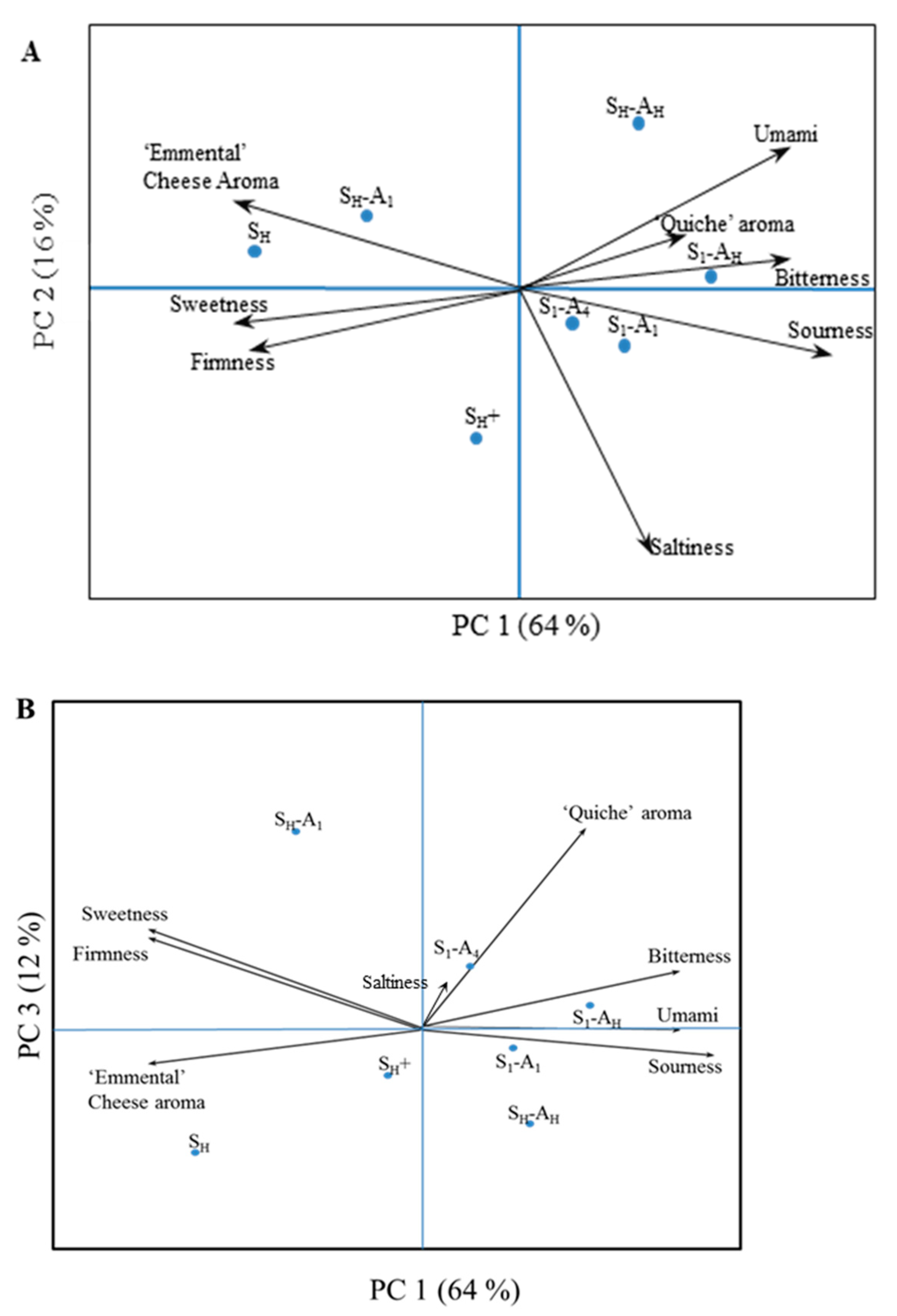
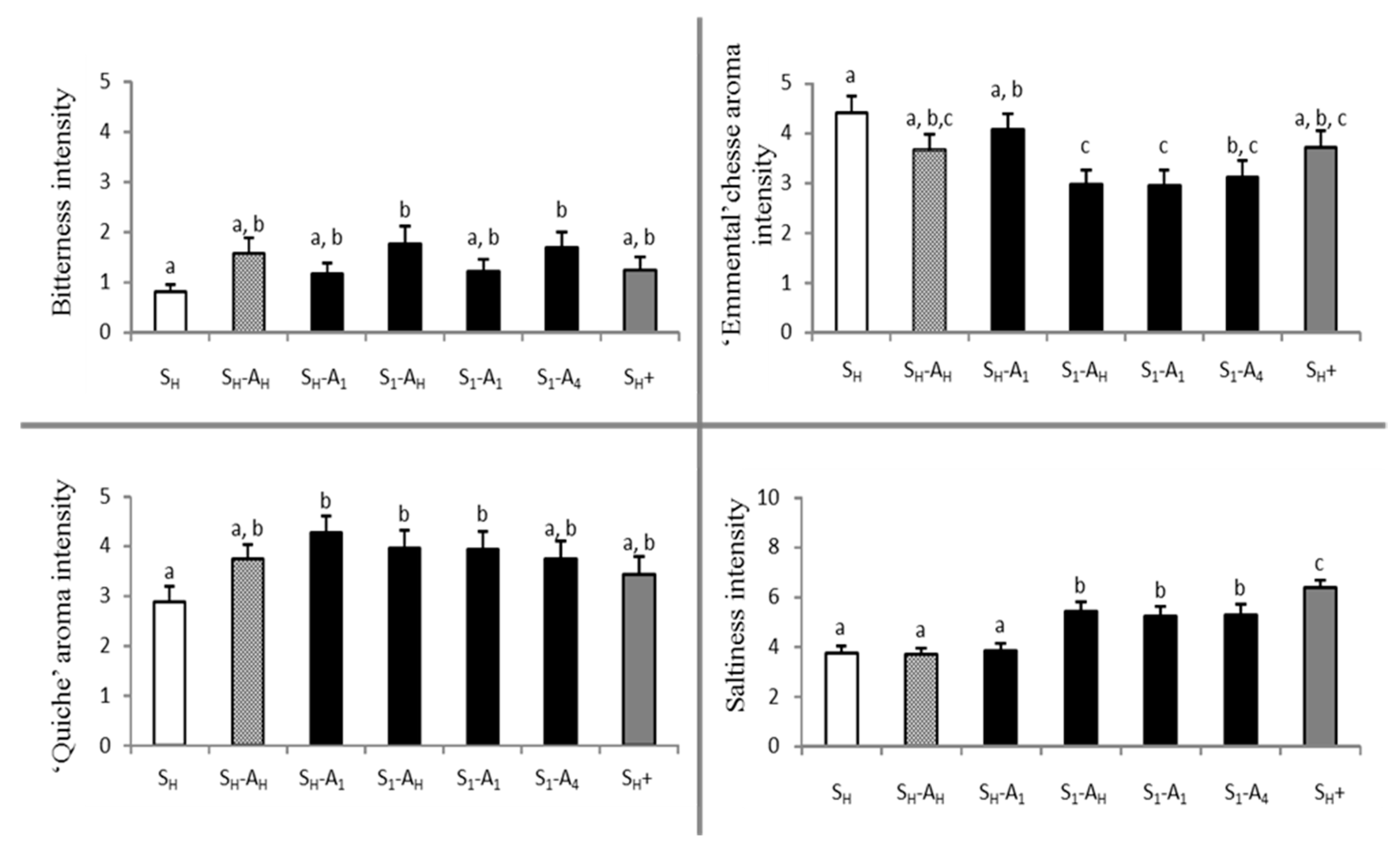
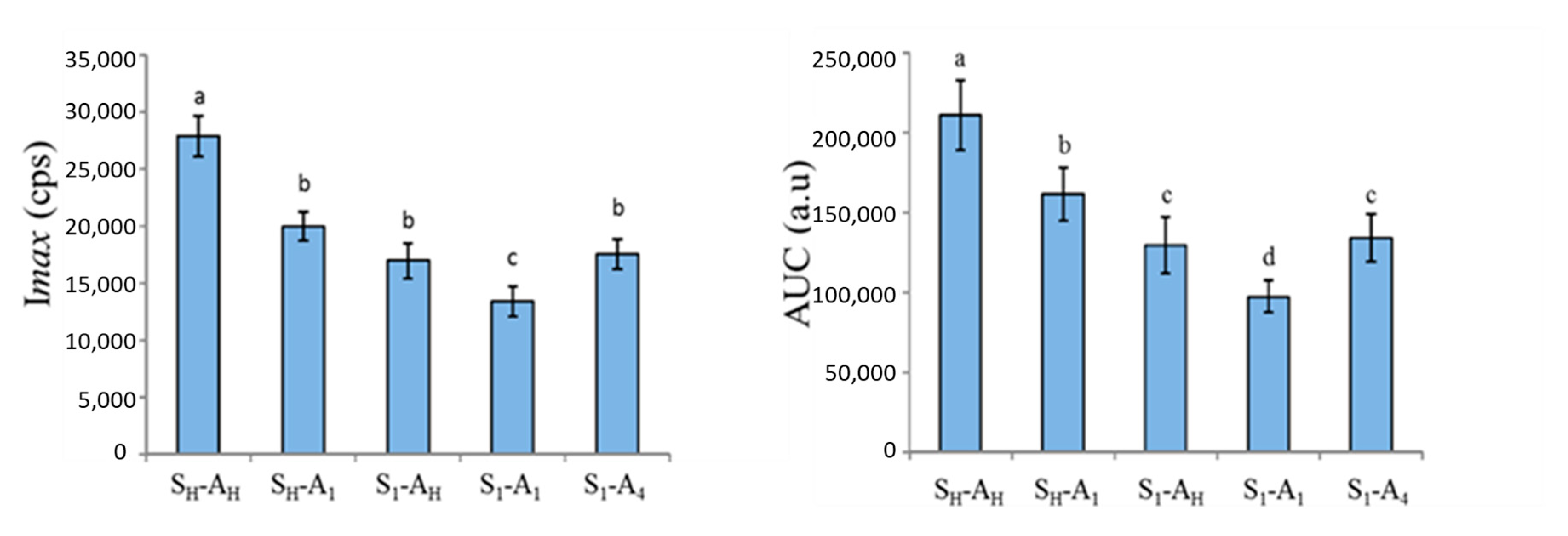
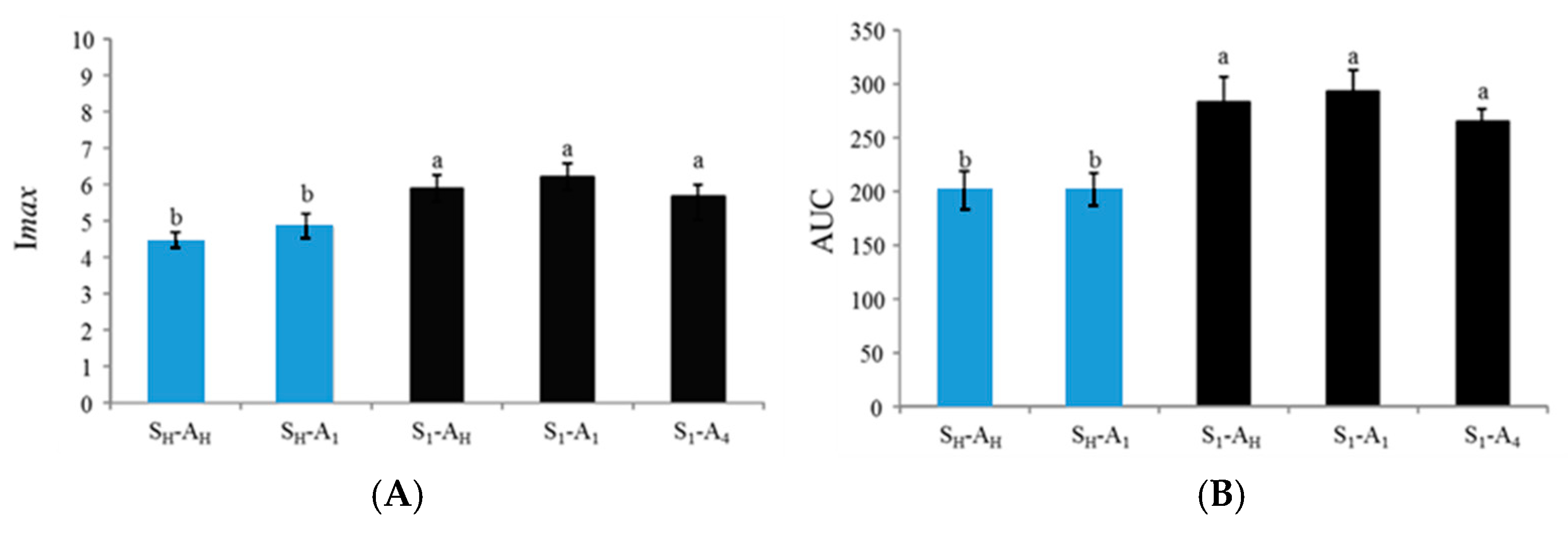

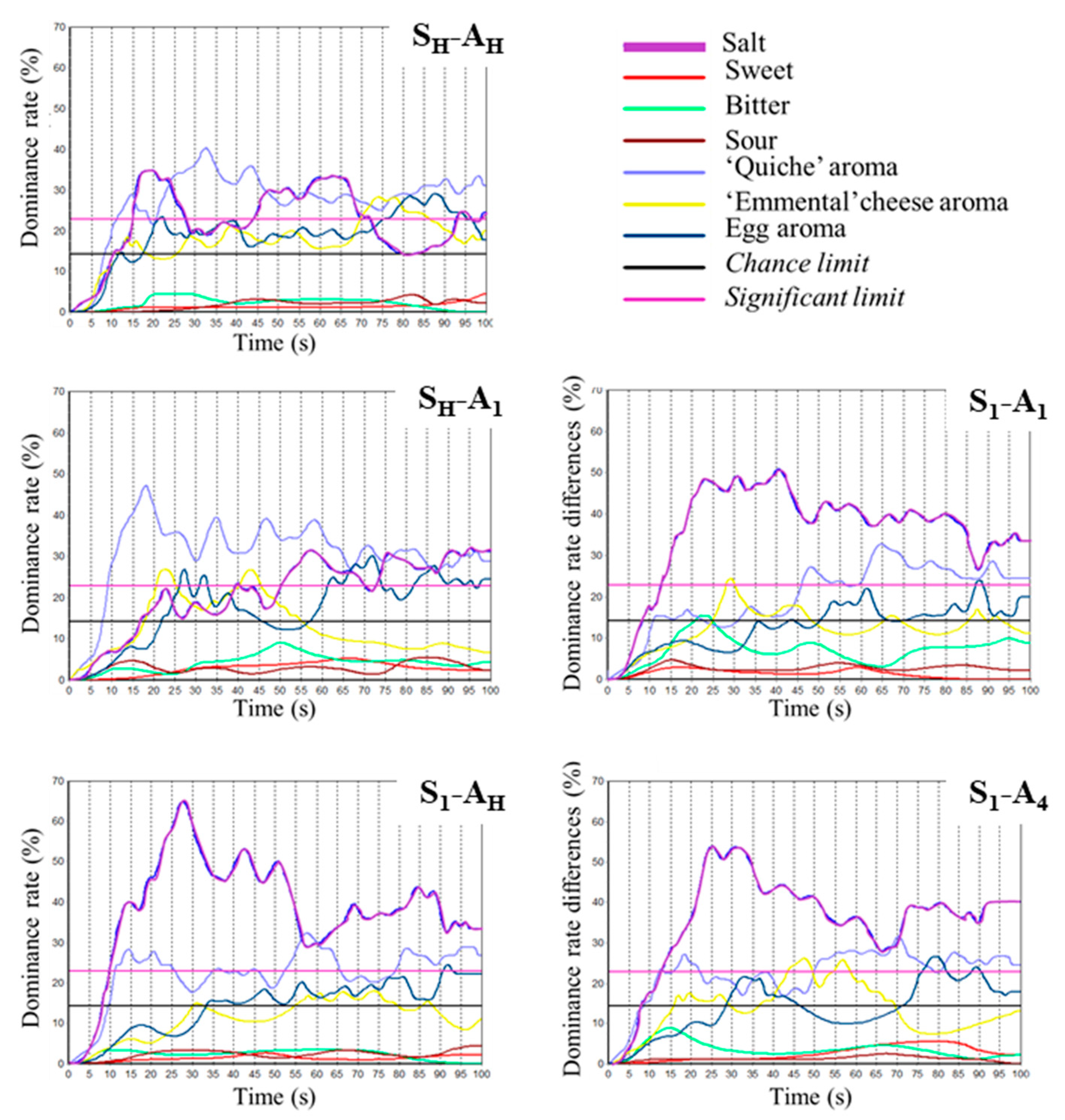
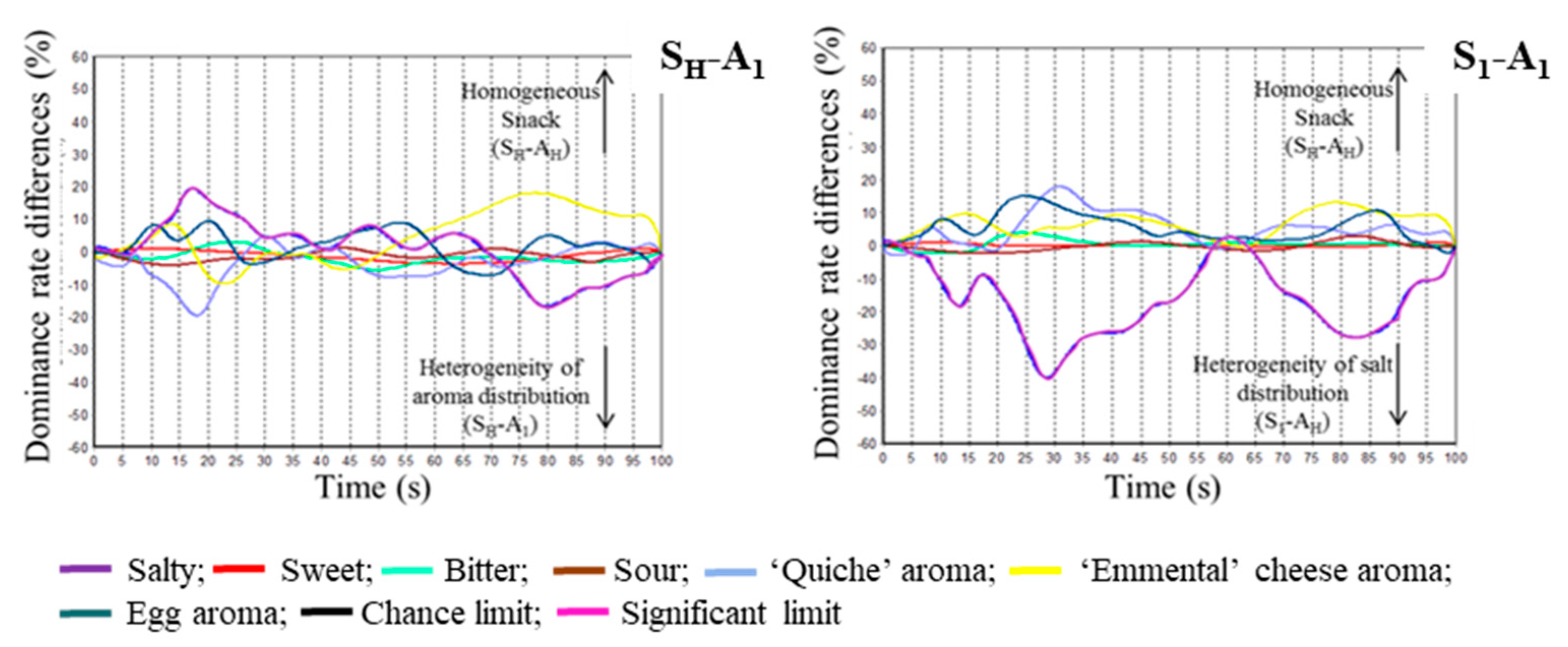
| Attributes | Mean Intensity | SD | F |
|---|---|---|---|
| Bitterness | 1.4 | 2.0 | 2.75 * |
| Sourness | 1.5 | 2.1 | 1.7 NS |
| Sweetness | 1.8 | 2.1 | 0.7 NS |
| Umami | 2.1 | 2.3 | 1.8 NS |
| Saltiness | 4.8 | 2.6 | 16.8 *** |
| Firmness | 6.5 | 2.3 | 1.1 NS |
| Quiche | 3.7 | 2.4 | 2.9 ** |
| Emmental | 3.6 | 2.5 | 4.6 *** |
| Ions | Factor | Imax | Tmax | AUC |
|---|---|---|---|---|
| Judge | 15.71 *** | 20.21 *** | 115.54 *** | |
| m/z 115.1117 | Replication | 1.59 NS | 0.55 NS | 0.29 NS |
| (heptan-1-ol) | Product | 0.80 NS | 2.50 * | 0.18 NS |
| m/z 103.0754 | Judge | 8.55 *** | 10.07 *** | 31.16 *** |
| (ethyl propanoate) | Replication | 2.71 NS | 0.26 NS | 0.50 NS |
| Product | 20.58 *** | 1.69 NS | 19.65 *** |
Publisher’s Note: MDPI stays neutral with regard to jurisdictional claims in published maps and institutional affiliations. |
© 2021 by the authors. Licensee MDPI, Basel, Switzerland. This article is an open access article distributed under the terms and conditions of the Creative Commons Attribution (CC BY) license (http://creativecommons.org/licenses/by/4.0/).
Share and Cite
Emorine, M.; Septier, C.; Martin, C.; Cordelle, S.; Sémon, E.; Thomas-Danguin, T.; Salles, C. Salt and Aroma Compound Distributions Influence Flavour Release and Temporal Perception While Eating Hot-Served Flans. Molecules 2021, 26, 1300. https://doi.org/10.3390/molecules26051300
Emorine M, Septier C, Martin C, Cordelle S, Sémon E, Thomas-Danguin T, Salles C. Salt and Aroma Compound Distributions Influence Flavour Release and Temporal Perception While Eating Hot-Served Flans. Molecules. 2021; 26(5):1300. https://doi.org/10.3390/molecules26051300
Chicago/Turabian StyleEmorine, Marion, Chantal Septier, Christophe Martin, Sylvie Cordelle, Etienne Sémon, Thierry Thomas-Danguin, and Christian Salles. 2021. "Salt and Aroma Compound Distributions Influence Flavour Release and Temporal Perception While Eating Hot-Served Flans" Molecules 26, no. 5: 1300. https://doi.org/10.3390/molecules26051300
APA StyleEmorine, M., Septier, C., Martin, C., Cordelle, S., Sémon, E., Thomas-Danguin, T., & Salles, C. (2021). Salt and Aroma Compound Distributions Influence Flavour Release and Temporal Perception While Eating Hot-Served Flans. Molecules, 26(5), 1300. https://doi.org/10.3390/molecules26051300







